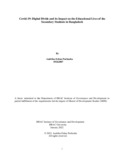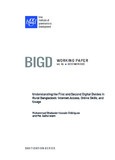| dc.contributor.advisor | Sultana, Razia | |
| dc.contributor.author | Purbasha, Audrika Eshna | |
| dc.date.accessioned | 2022-08-08T05:24:29Z | |
| dc.date.available | 2022-08-08T05:24:29Z | |
| dc.date.copyright | 2022 | |
| dc.date.issued | 2022-01 | |
| dc.identifier.other | ID 19262007 | |
| dc.identifier.uri | http://hdl.handle.net/10361/17067 | |
| dc.description | This thesis is submitted in partial fulfillment of the requirements for the degree of Masters of Development Studies, 2022. | en_US |
| dc.description | Cataloged from PDF version of thesis. | |
| dc.description | Includes bibliographical references (pages 63-72). | |
| dc.description.abstract | Ever since the widespread use of ICT, the digital divide has been prominent across different socioeconomic groups and gender in Bangladesh (Zahan, 2021). Moreover, the digital platform being the only medium to study during the school closure period, many students have been found to have a hampered educational life. A recent study jointly conducted by the PPRC and BIGD found that 19 percent of primary students and 25 percent of secondary students are at learning loss risk (Rahman & Matin, 2021). Nevertheless, several studies have been conducted which targeted to understand the child marriage and involvement in paid work as contributing factors to impacting educational lives of secondary students including learning loss risk but not much light had been shed on the in-depth investigation of the relation of the digital divide and the educational lives of the secondary students. Therefore, the purpose of this study is to explore how DAD (digital access divide) and DCD (digital capability divide) are impacting the educational lives of secondary school students during the school closure phase of the Covid-19 pandemic. Using a qualitative case study method this research conducted 10 in-depth interviews (IDI) with the variation of rural-urban and male-female secondary school students from Mymensingh, Sylhet, and Dhaka divisions. Two KII were also conducted where the Key Informants were from academic and government policy levels. The initial observations suggest that most of the secondary school students of both rural and urban areas do not have access to digital devices (smartphones, computers, etc.) to be used for educational purposes. Besides, female students are more comfortable with non-interactive (TV, radio) platforms while male students prefer interactive platforms. Another observation suggested that students are now finding it difficult to understand their lessons after reopening of the school. Figuring out any existing gap would thereby aid in future policy implications and appropriate interventions. | en_US |
| dc.description.statementofresponsibility | Audrika Eshna Purbasha | |
| dc.format.extent | 80 pages | |
| dc.language.iso | en | en_US |
| dc.publisher | Brac University | en_US |
| dc.rights | Brac University theses are protected by copyright. They may be viewed from this source for any purpose, but reproduction or distribution in any format is prohibited without written permission. | |
| dc.subject | Digital divide | en_US |
| dc.subject | Digital access | en_US |
| dc.subject | Digital capability | en_US |
| dc.subject | Educational lives | en_US |
| dc.subject | Secondary students | en_US |
| dc.subject | Digital device | en_US |
| dc.subject.lcsh | COVID-19 (Disease) | |
| dc.subject.lcsh | Developing countries -- Economic policy -- 21st century. | |
| dc.subject.lcsh | Education, Secondary | |
| dc.title | Covid-19: digital divide and its impact on the educational lives of the secondary students in Bangladesh | en_US |
| dc.type | Thesis | en_US |
| dc.contributor.department | BRAC Institute of Governance and Development, Brac University | |
| dc.description.degree | M. Development Studies | |




